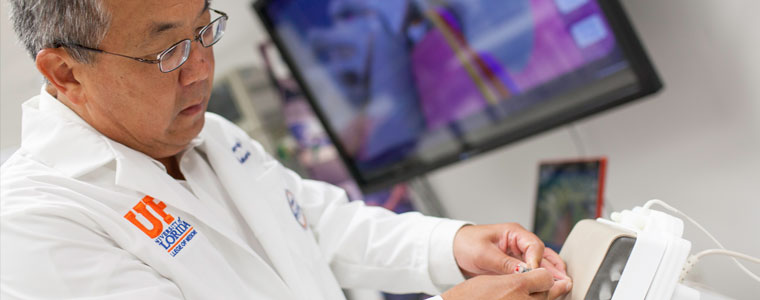On the battlefield, wounded soldiers depend on how quickly and efficiently medical personnel can treat and stabilize their life-threatening injuries.
To help military medical personnel acquire, practice or maintain these key skills while deployed, University of Florida and U.S. Army Research Laboratory Simulation and Training Technology Center researchers have received a $1.75 million grant to design, develop and validate a set of portable, rugged simulators to help military clinicians train — no matter where in the world they happen to be.
“If something happens, like 9/11, personnel may get shipped out with little or no time for training stateside,” said the study’s principal investigator, Samsun “Sem” Lampotang, Ph.D., a professor of anesthesiology in the UF College of Medicine and director of the UF Center for Safety, Simulation & Advanced Learning Technologies. “But while stationed overseas in combat zones or waiting for hostilities to start, reservists may still need training to become proficient with unfamiliar military medical procedures or equipment not routinely used in civilian medicine. Each of the proposed simulators will fit inside a military-spec padded case that meets airline-checked luggage size requirements so they can be readily deployed.”
With funding from the Telemedicine & Advanced Technology Research Center, a subcommand of the U.S. Army Medical Research and Materiel Command, Lampotang’s team is building and testing mixed-reality simulators for five different medical procedures. The proposed simulators are based on innovative technologies developed at UF, which UF Health researchers are tailoring and improving to meet the military’s needs. The first simulator enables health care workers to practice central venous access — placing a central line — to quickly introduce medication and fluids into the body. The procedure requires precise skill because the needle can puncture the lung or artery if not guided properly, Lampotang said.
During the simulation, trainees attempt to place the tip of a tracked needle into the vein of an anatomically correct 3-D model. Each movement is tracked through a miniature sensor embedded near the needle tip and activity is shown on a linked laptop. As soon as the user correctly places the needle tip into the target vein, the syringe lights up blue to simulate blood that would flow out of the vein. The simulator also alerts users when the needle tip has inadvertently struck the lung or an artery.
Another simulator originally developed for UF’s Department of Neurosurgery will help military clinicians practice relieving pressure in the brain after injury. In this procedure a catheter needs to be precisely placed through a hole drilled in the skull to remove fluid from the brain. Practice is crucial because guiding the catheter into the wrong part of the brain could be fatal.
The third simulator researchers are adapting involves regional anesthesia.
The last two simulators under development involve chest tube insertion and a procedure called focused assessment with sonography for trauma, or FAST, which enables medics to pinpoint internal wounds.
In addition to developing the simulator technology, the research team, which includes UF Health Jacksonville faculty, will assess whether the simulators are effective as training tools, change actual patient care practices, improve patient outcomes and are cost-effective.
Source:
- Samsun Lampotang, slampotang@anest.ufl.edu

